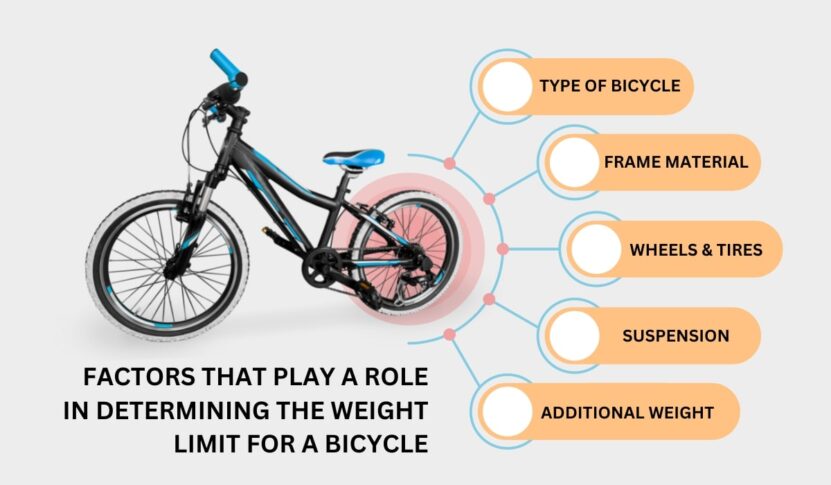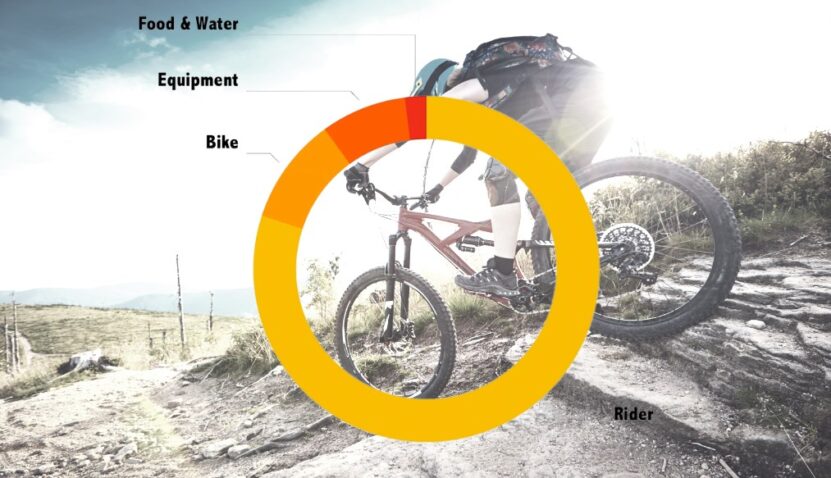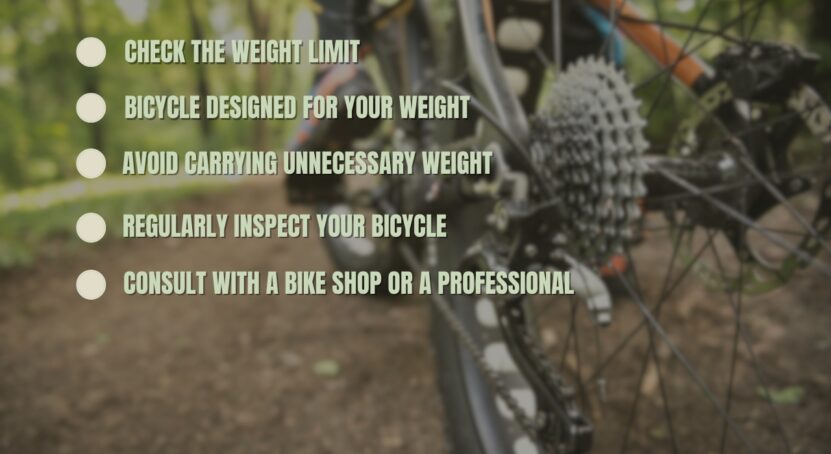Ever found yourself pondering if a bike has a weight limit? If you’re asking, you probably already know the answer.
Does this mean you’re forever banished from the kingdom of cycling? Not on my watch! Together, we’ll delve into the mysteries of bike weight limits and find the perfect steed to carry your majestic self.
A weight limit for a bicycle determines the maximum weight that a bike can safely handle. This includes the weight of the rider (that’s you, my friend) and any additional weight such as a backpack or a load on a cargo bike. It’s a crucial safety consideration for riders, as exceeding it can cause damage to the bicycle, increase the risk of accidents, and lead to injuries. And trust me, explaining to the ER nurse how you broke your arm because you overloaded your bike is not a conversation you want to have.
What Is Too Heavy?
Bicycles come with a specific weight limit. This limit is set by the manufacturer and can vary depending on the type of bike, the material it’s made from, and a few other factors. For instance, a road bike designed for racing might have a lower weight limit due to its lightweight frame, compared to a mountain bike built for off-road adventures or a cargo bike designed to haul hefty loads.
Those steel-constructed bicycles might look like they could support a small elephant, but in reality, a regular bicycle can bear up to 300-400 lbs. But hey, if you’re a larger lad, don’t let this get you down. Some bikes can handle around 500 lbs.
These heavy-duty stallions are specially designed bicycles for us well-rounded individuals or people who need to carry heavy loads on their cycles. So, no matter your size, there’s a bike out there for you.
Factors Affecting Weight Limits

Now, let’s talk about the factors that play a role in determining the weight limit for a bicycle. It’s not just about the number on the scale chief. Here’s the rundown:
Type of Bicycle
Just like how different cars are designed for different purposes, the same goes for bikes. A sleek road bike isn’t going to carry the same load as a sturdy mountain bike. Road bikes are designed for speed and efficiency on pavement, not for carrying heavy loads.
Meanwhile, mountain bikes and cargo bikes are built to withstand rough terrain and heavier weights, making them a better choice for the more generously proportioned among us.
Frame Material
What your bike is made of matter:
- Steel might be real, but it’s also heavy. It’s durable and can handle a lot of weight, but you might find yourself working harder to pedal.
- Aluminum is lighter but might not be as strong. It’s a good middle-of-the-road option for those of us who are a bit heavier.
- Carbon fiber? Light and strong, but your wallet might not thank you. It’s the priciest option, but it offers the best strength-to-weight ratio.
Wheels and Tires
The wheels carry the load, so their strength is crucial. Stronger wheels can handle more weight, but they might also be heavier.
And the tires? They’re like the shoes of your bike. You wouldn’t wear flip-flops for a marathon, would you? Similarly, wider tires can support more weight and provide a smoother ride, but they might also slow you down.

Suspension
If your bike has suspension, it needs to be able to handle the weight. It’s like the shocks on your car – if they’re not up to the task, you’re in for a bumpy ride.
A good suspension system can make a big difference in comfort and control, especially for heavier riders. But remember, more suspension can also mean more weight, so it’s a balancing act.
Seat
Yes, even the seat matters. It’s not just about comfort – it has to support your weight too.
A wider seat can distribute your weight more evenly, making for a more comfortable ride. But don’t forget about the seat post! It needs to be strong enough to support you as well.
Structural Weight Limit
This is the maximum weight the bike can handle, including you and any extra gear. It’s like the maximum occupancy sign in an elevator – ignore it at your peril.
Exceeding this limit can lead to damage or even failure of the bike, so it’s important to know what it is and respect it.
Additional Weight
Speaking of extra gear, anything you add to your bike counts toward the weight limit. So if you’re planning a long trip, pack light!
Every extra pound can make a difference in how your bike handles and how hard you have to work. And remember, it’s not just about the weight of your gear – the weight of your lunch counts too!
How to Identify the Weight Limit?

Follow these steps:
- Check the Manual: The weight limit for your bicycle can often be found in the owner’s manual or on the manufacturer’s website. If you no longer have the manual, you can search for it online by entering the make and model of your bike.
- Look for a Sticker or Tag: In many cases, the limit may be indicated on a sticker or tag located on the frame of the bike. The sticker or tag may be located near the seat post or on the underside of the frame.
- Contact the Manufacturer: If you are unable to find it through the owner’s manual or by searching online, you can contact the manufacturer directly for more information. They should be able to provide you with the weight limit or point you in the direction of where to find it.
- Consult with a Bike Shop: A bike shop can also help you determine the weight limit for your bike. They may have access to information about the specific model and be able to provide you with guidance on weight limits for different types of riding.
It is important to note that the weight limit is a safety requirement, not a recommendation. Exceeding the weight limit can cause damage to the bike and lead to accidents and injuries. As such, it is essential to adhere to the weight limit for your bike to ensure a safe and enjoyable riding experience.
How About a Second-Hand Bike?

So, you purchased a second hand bike before you knew about weight limits, and now your wondering how to identify your new rides capacity. Well, its still simple:
- Identify the Make and Model: The first step is to identify the make and model of your bike. This information can often be found on the frame of the bike or by conducting a search online.
- Look for Similar Bikes: Once you have identified the make and model of your bike, you can look for similar bikes online and compare their weight limits. Many bike manufacturers provide weight limits for their different models, so you may be able to find it in this way.
- Consult with a Bike Shop: They may be able to provide you with information about the weight limits of similar bikes or may have experience with the specific model of your bike.
- Consider the Condition of the Bike: The condition of the bike can also impact the weight limit. If the bike is older or has been heavily used, it may have a lower weight limit than when it was new. This is because wear and tear can weaken the frame and components of the bike over time.
Also check out: How To Keep A Bike From Rusting Outside
Why Do Some Bikes Have Heavier Limits?
If you pay attention to the bikes the heavyweight capacity and the regular ones may seem the same to you. But, what makes heavy-duty bikes bear greater loads than regular ones?
Well, the answer to that are many factors that are:
- The construction material of the bike’s overall body. Carbon and titanium are preferred more in regular bikes due to their finish and quality. But they may break down or bent under higher pressure so a bike with a steel or steel alloy body is good
- Bikes designed for rough terrains such as mountains are great for heavy riders, as they are customized to handle downhill impacts, stronger forces, and higher friction roads.
- A bike for overweight riders is preferred to be simple with no or fewer folding parts in design as the joints may creak under high pressure
- Tires wider with uniform weight distribution and ample cushioning ensures comfort in the ride for heavy riders
- Coming to the suspension if it’s more rigid and suspension forks durable then they can handle the heavyweight pressure and won’t be just compressed down with the rider’s weight.
- Rim with more spokes will give more stability and strength to the bike.
Always look for the total weight capacity of the bike as mentioned separately on the manual, so that you can calculate the riders weight plus the cargo you want to carry
Different Types Limits

The weight limits for bicycles can be as varied as the toppings on a pizza, depending on the brand, model, and type of bike. Generally, the weight limit for a bicycle is determined by a smorgasbord of factors, including the strength of the frame, wheels, and other components.
It’s crucial to remember that weight limits can swing more wildly than a pendulum, depending on the type of bicycle and the manufacturer. It’s like comparing apples and oranges, or in our case, road bikes and mountain bikes. Here are some examples to give you a taste:
| Type of Bike: | Weight Limit: |
|---|---|
| Hybrid bike | 300 – 350 lbs |
| Road bike | 220 – 275 lbs |
| Mountain bike | 300 lbs |
| Fat bike | 300 – 400 lbs |
| Gravel bike | 275 – 330 lbs |
| City bike | 300 lbs |
| Folding bike | 190 – 280 lbs |
| Electric bike | 220 – 400 lbs |
What Happens If You Exceed the Weight Limit?

Now, you might be wondering, ‘What happens if I treat the weight limit like a suggestion rather than a rule?’ Well, my friend, let me paint a picture for you.
Imagine you’re at a buffet. You’ve piled your plate high with all your favorites, and you’re going back for seconds… and thirds. Eventually, that plate is going to buckle under the weight, right? The same principle applies to your bike.
Exceeding the weight limit can lead to a variety of issues. The frame could bend or even break, which is about as fun as stepping on a Lego barefoot. The wheels could warp, leading to an unstable and unsafe ride.
The tires could also wear out faster, and you might find yourself getting more flats. And let’s not forget about the brakes. Overloading your bike can put extra strain on the brakes, making them less effective.
Tips for Riding Within the Limit

To ensure your safety and protect your bicycle, here are some tips for riding within the weight limit:
- Check the weight limit for your bicycle and ensure that your weight plus any additional weight is below the limit.
- Use a bicycle designed for your weight and riding style.
- Avoid carrying unnecessary weight, and distribute the load evenly on a cargo bike.
- Regularly inspect your bicycle for signs of damage and wear, especially if you ride frequently or carry heavy loads.
- Consult with a bike shop or a professional mechanic for guidance on maintaining and repairing your bicycle.
Tips for Heavy Bicycle Riders
If you are a heavy bicycle rider, there are a few tips that can help you have a safe and enjoyable cycling experience:
Choose the right bike:
When it comes to picking a bike, always opt for a bike that’s designed to carry your weight and suits your style.
If you’re feeling a bit lost in the sea of options, fear not! I’ve got three top-notch suggestions from reputable bicycle manufacturers to help you on your bike journey. All deserve a swipe to the right, the power is in your hands.
1. Roscoe 8 by Trek
This bike by Trek is like the Hulk of bicycles – sturdy, durable, and ready to handle anything. With its wide design, rugged construction, and tires that are wider than my love for pizza (27.5+ to be exact), this bike is ready to take on any terrain. Thanks to its mountain bike features and 1*12 drivetrain, you’ll have great control, no matter where you ride.
2. CAADX by Cannondale
With a weight limit of 330 lbs., this bike isp ready to carry you and your cargo. It’s built tough and can handle the weight and any route with ease. It’s like the SUV of bikes – ready for anything you throw at it.
3. New Leaf by ZIZE bikes
This bike has a grip as firm as a professional wrestler and an impressive weight capacity of 550 lbs. It’s like the heavyweight champion of bikes. The rugged metal construction, wide and strong tires, and wheels offer great stability and uniform distribution of weight. It’s like riding on a cloud – a very sturdy cloud.
Bike Checklist
Get a Professional Bike Fitting
Think of a professional bike fitting as a tailor for your bike. It ensures that your bike is adjusted to your size and weight, which can help prevent discomfort and injury. It’s like getting a suit custom-made – the fit is everything. When you go for your fitting, wear comfortable clothes that aren’t too loose or too tight.
And if you’re not keen on showing off your legs in shorts or your arms in a sports shirt, trousers and zippers are perfectly fine alternatives. Remember, the goal is to be comfortable, not to win a fashion show.
Check the Tire Pressure
Tire pressure needs to be just right. Too low, and you risk flats and a sluggish ride. Too high, and your ride can be bumpy and uncomfortable.
Proper tire pressure can help prevent these issues and improve your overall riding experience. It’s like making sure your shoes are tied before you go for a run.
Start Slow and Build Up
If you’re new to cycling, don’t try to be the Usain Bolt of biking right off the bat. Start with shorter rides and gradually build up to longer ones. This can help prevent injury and improve your fitness over time. It’s like training for a marathon – you wouldn’t start by running 26.2 miles on your first day, would you (unless you’re David Goggins, then go ahead)?
Another key factor is to stop worrying about what others think and enjoy your ride. Focus on the road and avoid any bumps or potholes. Maintain an upright posture with a straight back to prevent aches and pains. Remember, you’re biking for you, not for anyone else.
Maintain your Bike
Your bike is like a pet – it needs regular care and attention. Regular maintenance, such as cleaning and lubricating the chain and keeping the tires properly inflated, can help extend the life of your bike and improve your riding experience. It’s like taking care of a car – a little bit of maintenance can go a long way.
Consult with a Doctor
If you have any health conditions or concerns, it’s a good idea to consult with a doctor before starting a new exercise program, including cycling. IYou want to make sure everything is in good working order before you hit the road.
FAQ

How Much Weight a Regular Bike Can Hold?
The weight a bike can carry is as varied as the toppings on a pizza. It depends on several factors, like the type of bike, the frame material, the components, and the overall design. Generally, a regular bicycle can carry anywhere from 250 to 300 pounds, but some bikes are like the bodybuilders of the cycling world and can carry much heavier loads.
Cargo bikes, for instance, are like the pickup trucks of bicycles. They’re designed to carry large amounts of weight and can have weight limits of 400 pounds or more. Electric bikes are also heavy lifters, with sturdier frames and stronger components.
Why Do Some Bikes Have Heavier Limits?
Some bikes have heavier weight limits because they’re designed to carry heavier loads or withstand more stress and pressure. It’s like comparing a sturdy hiking boot to a lightweight running shoe – they’re designed for different purposes.
Bikes with stronger frames made from materials like steel or aluminum can typically handle more weight than those with lighter frames. And bikes with stronger components, like thicker spokes and stronger rims, can also handle more weight.
The overall design of the bike also plays a role. Bikes designed for rough terrain, like mountain bikes, often have higher weight limits because they need to be able to handle more stress and pressure.
Can a 300-pound Person Ride a Bike?
Yes, a 300-pound person can ride a bike, but it’s important to choose a bike that’s designed to handle their weight. There are bikes available that can accommodate riders weighing up to 400 pounds or more. These bikes are typically designed with stronger frames, components, and wheels.
A professional bike fitting can help ensure a comfortable and safe ride. And if you’re a heavier rider interested in cycling, it’s important to consult with a doctor before starting a new exercise program. They can help you determine what types of exercise are safe and appropriate for you.
Why is it important to consider the weight limit on a bicycle before purchasing one?
It is important to consider the weight limit on a bicycle before purchasing one to ensure that the bike can safely support your weight and avoid potential accidents or injuries due to the failure of bike components, such as the frame or wheels.
Can modifications be made to a bike to increase its weight limit?
Yes, modifications can potentially be made, such as reinforcing the frame, upgrading to stronger wheels, and using wider tires, to accommodate more weight.
However, modifying a bike may void its warranty, and it is advisable to consult with a professional bike mechanic or the manufacturer before making such changes.
How often should one check the condition of a bicycle being used close to its weight limit?
When a bicycle is being used close to its weight limit, it is advisable to check its condition regularly, ideally before each ride, to ensure that there is no wear and tear or damage to critical components like the frame, wheels, and brakes that could compromise safety.
Do children’s bicycles also have weight limits?
Yes, children’s bicycles also have weight limits. It is crucial to adhere to these limits to prevent any damage to the bike or potential accidents, ensuring the child’s safety while riding.
Can the weight limit of a bicycle be considered as the sum of the rider’s weight and the cargo?
Yes, the weight limit of a bicycle includes both the rider’s weight and any additional load or cargo on the bike. Exceeding the total weight limit can risk damage to the bike and compromise safety.
Does exceeding the weight limit of a bicycle affect its performance and handling?
Absolutely. Exceeding the weight limit can negatively impact the performance and handling of the bicycle.
It can lead to quicker wear and tear of components, decreased stability, reduced efficacy of brakes, and overall less responsive handling, all of which could compromise the safety of the rider.
Concluding Thoughts
Well, my friend, we’ve cycled through the ins and outs of bike weight limits, explored the factors that affect them, and discovered some sturdy steeds ready to carry you on your cycling adventures. Remember, your weight doesn’t define your ability to enjoy the freedom of cycling. It’s all about finding the right bike that can handle your awesomeness.
We’ve learned that the weight limit of a bike is a safety guideline that ensures a smooth and safe ride. It’s like the speed limit on a road – it’s there for a reason, and it’s best to stick to it. And whether you’re a featherweight or a heavyweight, there’s a bike out there for you.
So, get out there, find your perfect bike, and start pedaling. After all, life is like riding a bicycle – to keep your balance, you must keep moving. Happy cycling!

